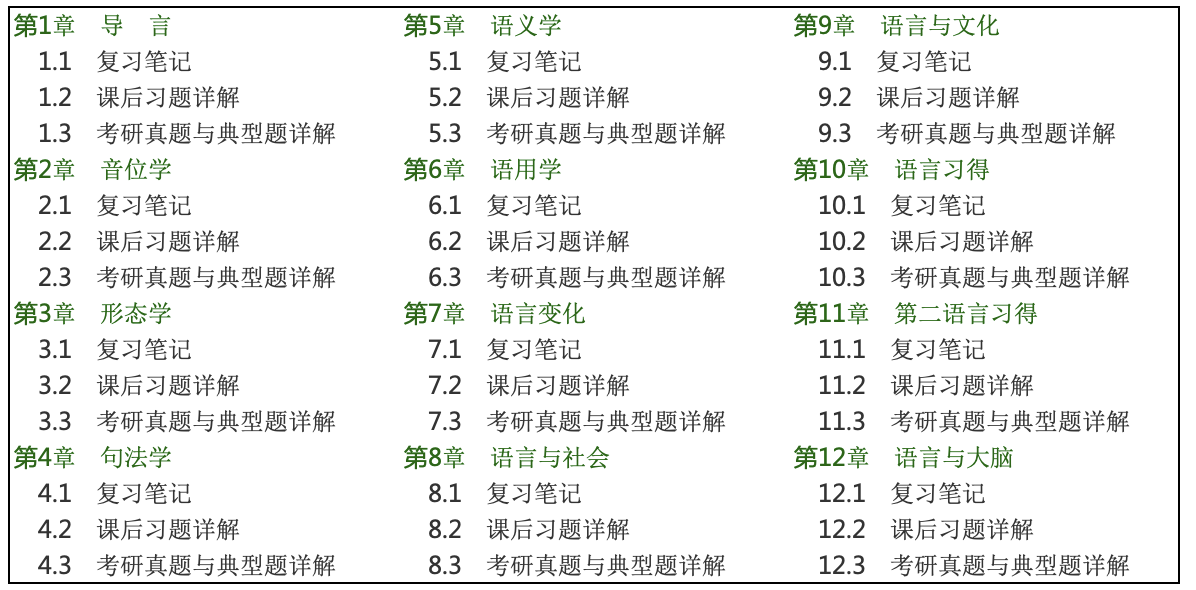戴炜栋《新编简明英语语言学教程》(第2版)笔记讲义考点归纳 【完整内容点击文中链接获取】
1. The definition and main branches of linguistics study
语言学的定义和研究的范围
2. Important distinctions in Linguistics
语言学的一些重要区分
3. The definition and the design features of language
语言的定义与识别特征
4. Functions of language
语言的功能
本章考点:
1. 有关语言学的常考考点
语言学的定义;语言学中几组重要区别,每组两个概念的含义、区分及其意义;普通语言学的主要分支学科及各自的研究范畴;宏观语言学及应用语言学的主要分支及各自的研究范畴。
2. 有关语言的常考考点
语言的定义;语言的识别特征(任意性、能产性、二重性、移位性、文化传递);语言的功能。
本章内容索引:
I. The definition of linguistics
II. The scope of linguistics
1. Micro-linguistics
2. Macro-linguistics
III. Some important distinctions in linguistics
1. Descriptive vs. Prescriptive
2. Synchronic vs. Diachronic
3. Speech vs. Writing
4. Langue vs. Parole
5. Competence vs. Performance
6. Traditional Grammar vs. Modern Linguistics
IV. The definition of language
V. The design features of language
1. Arbitrariness
2. Productivity
3. Duality
4. Displacement
5. Cultural Transmission
6. Interchangeability
VI. Functions of language
1. Main functions
2. Basic functions
3. Macrofuntions
I. The definition of linguistics(语言学的定义)
Linguistics is generally defined as the scientific study of language.
It is a scientific study because it is based on the systematic investigation of linguistic data, conducted with reference to some general theory of language structure.
语言学通常被定义为对语言进行科学性研究的学科。
它之所以是一种科学研究,是因为它是以对语言学数据的系统调研为基础,以语言结构的某种普遍理论为参照展开研究的。
II. The scope of linguistics(语言学的研究范畴)
The study of language as a whole is often called general linguistics.
作为整体而言的语言研究通常被称为普通语言学。
1. Micro-linguistics (from the core of linguistics) (微观语言学)
Phonetics: the study of sounds used in linguistic communication.
Phonology: the study of how sounds are put together and used to convey meaning in communication.
Morphology: the study of the way in which the symbols are arranged and combined to form words.
Syntax: the study of the rules in the combination of words to form grammatically permissible sentences in languages.
Semantics: the study of meaning.
Pragmatics: the study of meaning in the context of language use.
语音学:对语言交际中所使用的语音的研究。
音系学:对在交际中语音是如何被组合在一起、如何用来传递意义等问题的研究。
形态学:对于语言符号的排列方式和构词的组合方式的研究。
句法学:对支配构成语法所允许的句子的单词的组合的规则的研究。
语义学:对于意义的研究。
语用学:对具体语境中语言的意义的研究。
2. Macro-linguistics (from the relation with other fields)(宏观语言学)
Sociolinguistics: the study of all social aspects of language and its relation with society form the core of the branch.
Psycholinguistics: the study of language and its relation with psychology.
Applied linguistics: The study of the applications of language to the solution of practical problems. Narrowly, it is the application of linguistic theories and principles to language teaching, especially the teaching of foreign and second languages.
社会语言学:对语言的所有社会层面以及它与社会的关系的研究。
心理语言学:对语言及它与心理的关系的研究。
应用语言学:对应用语言解决实际问题的研究,如用于恢复言语等。从狭义上来讲,应用语言学指的是将语言学理论和原则应用于语言教学中,尤其是外语和第二语言教学。
| 内容来源 |
戴炜栋《新编简明英语语言学教程》(第2版)笔记  |
III. Some important distinctions in linguistics(语言学中一些重要的区分)
1. Descriptive vs. Prescriptive(描写式与规定式)
If a linguistic study aims to describe and analyze the language people actually use, it is said to be descriptive.
If the linguistic study aims to lay down rules for “correct and standard!” behavior in using language, i. e. to tell people what they should say and what they should not say, it is said to be prescriptive.
如果一种语言学研究旨在对人们实际使用的语言进行描写和分析的话,它就是描写性的。
如果语言学研究的目的是为语言运用中的“正确的和标准的”言语行为确立规则的话,如告诉人们应该说什么、不应该说什么,那么它就是规定性的。
2. Synchronic vs. Diachronic(共时性与历时性)
The description of a language at some point of time in history is a synchronic study.
The description of a language as it changes through time is a diachronic study.
A diachronic study of language is a historical study; it studies the historical development of language over a period of time.
对语言在历史上的某一时间点进行的描写就是共时性研究。
对语言随时间变化而变化进行的描写就是历时性研究。
语言的历时性研究是一种历史性研究;它研究语言在某一个时间段的历史演变。
3. Speech vs. Writing(言语与文字)
Speech and writing are the two major media of linguistic communication. Modern linguistics regards the spoken language as the natural or the primary medium of human language.
言语和文字是语言交际的两个主要媒介。现代语言学把口头语看作是人类语言的自然的或基本的媒体。
4. Langue vs. Parole(语言与言语)
Saussure distinguished the linguistic competence of the speaker and the actual phenomena or data of linguistics (utterances) as langue and parole. Langue refers to the abstract linguistic system shared by all the members of a speech community and parole refers to the realization of langue in actual use.
索绪尔用语言和言语来区分说话者的语言能力和言语上(表达的)的实际表现或语料。语言是指一个语言群体的所有成员所共有的抽象的语言系统。言语是指语言的具体实现和运用。
5. Competence vs. Performance(语言能力与语言应用)
(1) Chomsky made the fundamental difference between competence and performance.
(2) A language user’s underlying knowledge about the system of rules is called his linguistic competence.
(3) Performance refers to the actual use of language in concrete situations.
(4) Contrast between Saussure’s and Chomsky’s distinction
(1)乔姆斯基提出了语言能力和语言应用的根本区别。
(2)一名语言使用者对于语言规则系统的潜在认识称为他的语言能力。
(3)语言运用指在具体场景中语言的实际运用。
(4)索绪尔与乔姆斯基的区分的异同
【考点:比较Saussure和Chomsky的两对概念的异同】
①Saussure’s distinction and Chomsky’s are very similar.
②They differ at least in that Saussure took a sociological view of language and his notion of langue is a matter of social conventions, and Chomsky looks at language from a psychological point of view and to him competence is a property of the mind of each individual.
①索绪尔的区分与乔姆斯基的非常相似。
②他们从根本上还是有区别的,因为索绪尔对语言采取的是社会学的观点,他的语言观念是社会惯例性的,而乔姆斯基则是从心理学的角度来看待语言的,对他而言,语言能力是每个个体的大脑特征。
……

【完整版】 达聪网 戴炜栋《新编简明英语语言学教程》(第2版)笔记和课后习题(含考研真题)详解
热门内容
戴炜栋《新编简明英语语言学教程》(第2版)配套题库【考研真题精选+章节题库】
戴炜栋《新编简明英语语言学教程》(第2版)全套资料【笔记+题库】
陈新仁《英语语言学实用教程》(第2版)全套资料【笔记+题库】








